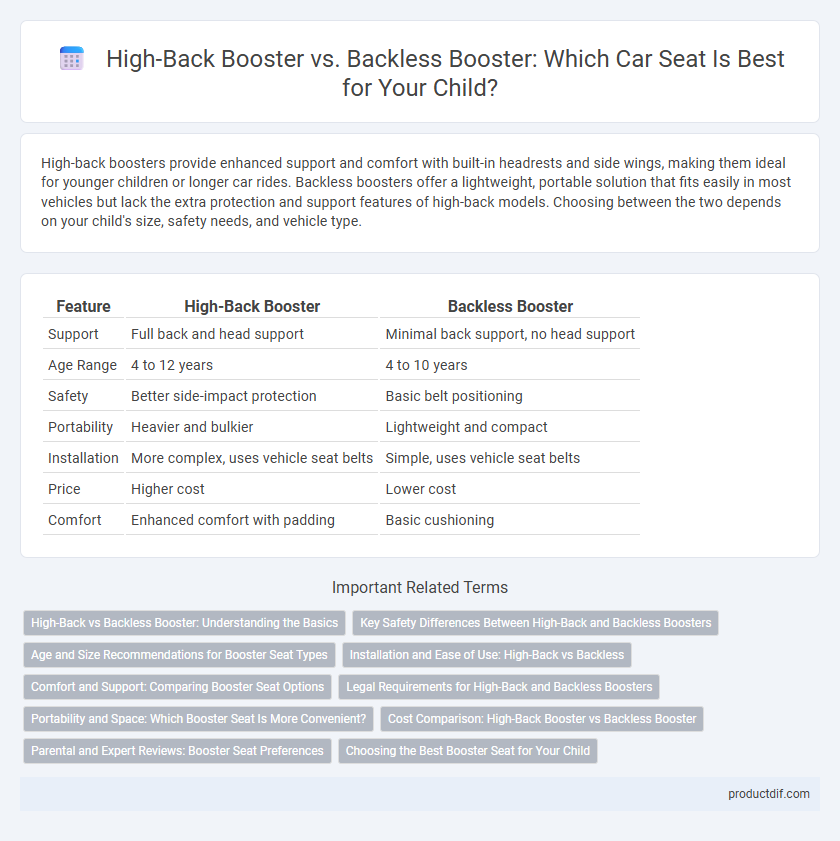High-back boosters provide enhanced support and comfort with built-in headrests and side wings, making them ideal for younger children or longer car rides. Backless boosters offer a lightweight, portable solution that fits easily in most vehicles but lack the extra protection and support features of high-back models. Choosing between the two depends on your child's size, safety needs, and vehicle type.
Table of Comparison
| Feature | High-Back Booster | Backless Booster |
|---|---|---|
| Support | Full back and head support | Minimal back support, no head support |
| Age Range | 4 to 12 years | 4 to 10 years |
| Safety | Better side-impact protection | Basic belt positioning |
| Portability | Heavier and bulkier | Lightweight and compact |
| Installation | More complex, uses vehicle seat belts | Simple, uses vehicle seat belts |
| Price | Higher cost | Lower cost |
| Comfort | Enhanced comfort with padding | Basic cushioning |
High-Back vs Backless Booster: Understanding the Basics
High-back boosters provide enhanced side-impact protection and support with built-in headrests, making them ideal for younger children or long trips. Backless boosters are compact, more portable, and better suited for older children who have outgrown the need for head and back support. Choosing between high-back and backless boosters depends on child age, vehicle seat design, and safety requirements.
Key Safety Differences Between High-Back and Backless Boosters
High-back boosters provide enhanced head and neck support, making them safer for vehicles without headrests and during side-impact collisions, while backless boosters rely solely on seat belts and require a vehicle with a proper headrest for optimal protection. The elevated seat back of high-back boosters ensures correct seat belt positioning over the shoulder and lap, reducing the risk of injury compared to backless models, which may cause belt misalignment. Safety experts recommend high-back boosters for younger children or those in vehicles lacking adequate seat design, emphasizing the critical role of proper support in child passenger safety.
Age and Size Recommendations for Booster Seat Types
High-back booster seats are ideal for children aged 4 to 12 years who weigh between 40 and 100 pounds, providing enhanced head and neck support for smaller or younger kids. Backless booster seats suit older children, typically from 4 to 12 years old weighing at least 40 pounds, who have developed sufficient head control and are tall enough to sit properly with the vehicle's seat belt positioning. Selecting the appropriate booster type depends on the child's size, height, and maturity to ensure optimal safety and comfort during car travel.
Installation and Ease of Use: High-Back vs Backless
High-back boosters typically offer easier installation thanks to integrated seatbelts and adjustable headrests, providing enhanced safety and comfort for toddlers. Backless boosters require careful positioning of the vehicle's seatbelt around the child, demanding more attention during installation to ensure proper fit. Parents often find high-back boosters more user-friendly for long trips, while backless boosters offer portability and ease for quick transfers between vehicles.
Comfort and Support: Comparing Booster Seat Options
High-back boosters provide enhanced comfort and support with padded side wings and headrests that protect toddlers during car rides while promoting proper posture. Backless boosters offer portability and ease of use but tend to lack the same level of side-impact protection and ergonomic support. Choosing between the two depends on the child's age, size, and the vehicle's seat design for optimal safety and comfort.
Legal Requirements for High-Back and Backless Boosters
High-back booster seats often meet stricter legal requirements due to their integrated side-impact protection and headrest, making them suitable for younger or smaller children under specific height and weight regulations. Backless boosters, while convenient and portable, must comply with local safety laws that typically restrict their use to children who have outgrown high-back boosters based on age, height, and weight thresholds. Both types require adherence to federal standards such as FMVSS 213 in the U.S., ensuring crash-test certification and proper seat belt positioning for child safety.
Portability and Space: Which Booster Seat Is More Convenient?
High-back booster seats offer enhanced support and safety but tend to be bulkier and less portable, making them less convenient for travel or shared use in multiple vehicles. Backless booster seats are more compact, lightweight, and easier to carry, providing greater convenience for parents looking to save space and maximize portability. Choosing between the two depends on the balance between safety features and the need for easy transport and storage.
Cost Comparison: High-Back Booster vs Backless Booster
High-back boosters typically cost between $50 and $150 due to enhanced safety features and adjustable headrests, while backless boosters range from $20 to $60, offering a budget-friendly option without integrated support. High-back models may justify the higher price with added comfort and side-impact protection, whereas backless boosters appeal to those prioritizing portability and affordability. Cost-effectiveness depends on specific needs, with high-back boosters favored for extended use and backless boosters for short-term, cost-conscious solutions.
Parental and Expert Reviews: Booster Seat Preferences
Parental and expert reviews consistently highlight safety and comfort as top priorities in choosing between high-back and backless booster seats. High-back boosters offer enhanced head and neck support, which experts recommend for younger children or vehicles without headrests, while many parents appreciate the portability and ease of use of backless boosters for older kids. Studies confirm that high-back boosters provide better belt fit and crash protection, influencing preference based on child age, vehicle type, and safety ratings.
Choosing the Best Booster Seat for Your Child
Choosing the best booster seat for your child depends on safety, comfort, and vehicle compatibility. High-back boosters offer superior head and neck support, ideal for younger children or cars without headrests, while backless boosters provide portability and ease of use for older kids who fit well with just the vehicle's seat belt. Ensuring the booster seat meets federal safety standards and fits your child's height and weight is crucial for optimal protection during travel.
High-Back Booster vs Backless Booster Infographic

 productdif.com
productdif.com